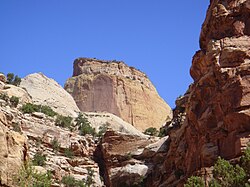| Carmel Formation | |
|---|---|
| Stratigraphic range: | |
 Carmel Formation at its type location, Mount Carmel, Utah | |
| Type | Geological formation |
| Unit of | San Rafael Group |
| Underlies | Entrada Sandstone |
| Overlies | Navajo Sandstone, Temple Cap Formation, Nugget Sandstone |
| Thickness | From 200 feet (60 m) to 1,000 feet (300 m) [1] |
| Lithology | |
| Primary | Mudstone |
| Other | Sandstone, siltstone, limestone |
| Location | |
| Coordinates | 37°15′04″N112°39′47″W / 37.251°N 112.663°W |
| Region | Wyoming, Utah, Colorado, north east Arizona and New Mexico |
| Country | US |
| Type section | |
| Named for | Mount Carmel |
| Named by | Gilluly and Reeside |
| Year defined | 1928 |


The Carmel Formation is a geologic formation in the San Rafael Group that is spread across the U.S. states of Wyoming, Utah, Colorado, north east Arizona and New Mexico. Part of the Colorado Plateau, this formation was laid down in the Middle Jurassic during the late Bajocian, through the Bathonian and into the early Callovian stages. [2]








